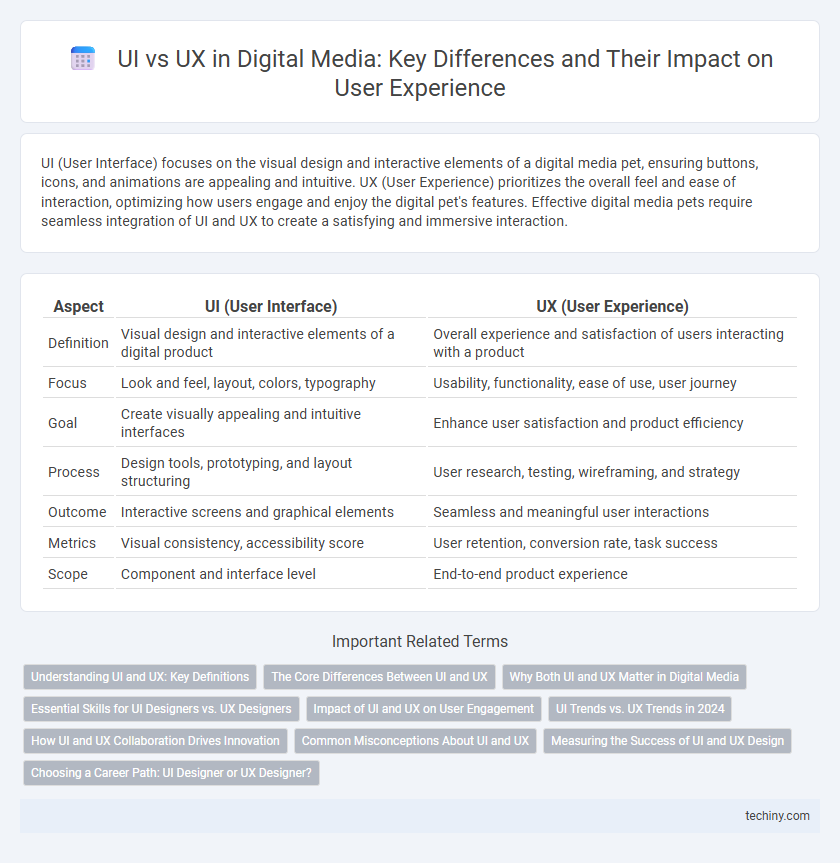UI (User Interface) focuses on the visual design and interactive elements of a digital media pet, ensuring buttons, icons, and animations are appealing and intuitive. UX (User Experience) prioritizes the overall feel and ease of interaction, optimizing how users engage and enjoy the digital pet's features. Effective digital media pets require seamless integration of UI and UX to create a satisfying and immersive interaction.
Table of Comparison
| Aspect | UI (User Interface) | UX (User Experience) |
|---|---|---|
| Definition | Visual design and interactive elements of a digital product | Overall experience and satisfaction of users interacting with a product |
| Focus | Look and feel, layout, colors, typography | Usability, functionality, ease of use, user journey |
| Goal | Create visually appealing and intuitive interfaces | Enhance user satisfaction and product efficiency |
| Process | Design tools, prototyping, and layout structuring | User research, testing, wireframing, and strategy |
| Outcome | Interactive screens and graphical elements | Seamless and meaningful user interactions |
| Metrics | Visual consistency, accessibility score | User retention, conversion rate, task success |
| Scope | Component and interface level | End-to-end product experience |
Understanding UI and UX: Key Definitions
UI (User Interface) refers to the visual elements and interactive components users engage with, including buttons, icons, and layouts, designed to facilitate seamless navigation. UX (User Experience) encompasses the overall feeling and satisfaction a user derives from interacting with a digital product, emphasizing usability, accessibility, and emotional impact. Understanding the distinction between UI and UX is crucial for creating designs that are not only visually appealing but also intuitive and user-centric.
The Core Differences Between UI and UX
UI (User Interface) focuses on the visual elements, layout, and interactive components users directly engage with, while UX (User Experience) emphasizes the overall feel, usability, and satisfaction throughout the entire interaction process. UI involves graphic design, colors, typography, and buttons, creating the aesthetic appeal, whereas UX encompasses user research, wireframing, and user testing to optimize flow and functionality. Understanding these core differences is essential for designing digital media products that are both attractive and user-friendly.
Why Both UI and UX Matter in Digital Media
UI and UX are critical in digital media because UI ensures visually appealing and intuitive interfaces that attract users, while UX focuses on seamless, satisfying interactions that keep users engaged and loyal. Together, they enhance user satisfaction, reduce bounce rates, and drive higher conversion rates across digital platforms. Effective collaboration between UI and UX teams leads to cohesive designs that meet both aesthetic and functional goals, crucial for competitive advantage in digital media environments.
Essential Skills for UI Designers vs. UX Designers
UI designers excel in visual communication, mastering skills like typography, color theory, and layout to create engaging interfaces. UX designers specialize in user research, information architecture, and interaction design to optimize usability and user satisfaction. Both roles require proficiency in prototyping tools, but UI focuses on aesthetics while UX emphasizes functionality and user behavior analysis.
Impact of UI and UX on User Engagement
User Interface (UI) and User Experience (UX) significantly influence user engagement by shaping how users interact with digital media platforms. Effective UI design enhances visual appeal and navigability, reducing friction and encouraging prolonged interaction, while comprehensive UX strategies address user satisfaction by tailoring functionality and accessibility to meet user needs. Together, optimized UI and UX increase retention rates, boost conversion, and foster brand loyalty in digital media environments.
UI Trends vs. UX Trends in 2024
UI trends in 2024 emphasize immersive visuals, including micro-interactions, dark mode enhancements, and adaptive layouts optimized for multi-device use. UX trends focus on personalized user journeys driven by AI, seamless accessibility features, and predictive analytics to enhance user engagement and satisfaction. Both UI and UX integrate real-time feedback mechanisms to create intuitive and responsive digital experiences.
How UI and UX Collaboration Drives Innovation
UI and UX collaboration drives innovation by seamlessly integrating visual design with user-centered functionality, leading to intuitive digital media experiences. Combining UI's focus on aesthetics with UX's emphasis on user behavior uncovers new interaction patterns that enhance engagement and satisfaction. This synergy accelerates iterative design processes and fosters creative solutions aligned with evolving user needs.
Common Misconceptions About UI and UX
Many confuse UI (User Interface) with UX (User Experience), mistakenly treating UI as merely the visual design and UX as the functionality; however, UI encompasses the overall interaction design, including layout, buttons, and visual elements, while UX covers the user's entire journey and emotional response. A common misconception is that strong UI guarantees good UX, but effective UX requires comprehensive research, usability testing, and intuitive design that considers user needs beyond aesthetics. Understanding that UI is a component within UX helps digital media professionals create interfaces that are not only visually appealing but also user-friendly and engaging.
Measuring the Success of UI and UX Design
Measuring the success of UI and UX design relies on key performance indicators such as user engagement, task completion rates, and customer satisfaction scores, which provide quantifiable insights into usability and user experience quality. Tools like heatmaps, A/B testing, and user feedback surveys enable designers to analyze interaction patterns and identify areas for improvement in both interface aesthetics and functional flow. Effective measurement integrates qualitative data with quantitative metrics to optimize digital media products, ensuring they meet user needs and business goals efficiently.
Choosing a Career Path: UI Designer or UX Designer?
Selecting a career path in digital media hinges on understanding the distinct roles of UI designers, who craft visually engaging and intuitive interfaces, versus UX designers, who focus on optimizing user interactions and overall experience. UI designers prioritize aesthetics, color schemes, and layout to enhance usability, while UX designers conduct user research, wireframing, and usability testing to solve user problems effectively. Aspiring professionals should evaluate their strengths in creativity, analytical thinking, and empathy to determine the best fit between UI or UX design roles.
UI vs UX Infographic

 techiny.com
techiny.com